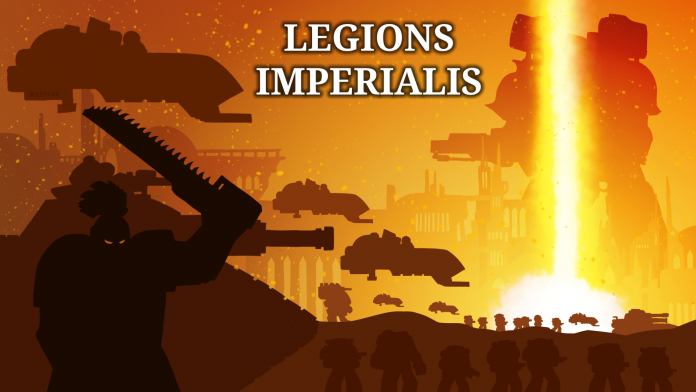It’s been a few months now since the release of the Rise of the Dark Mechanicum book for Legions Imperialis. It included rules for the Krios, Krios Venator and Karacnos tanks, which can be taken by both Mechanicum Taghmata and Dark Mechanicum armies. Their release means all the units in Rise of the Dark Mechanicum are now available.
Also striding into view are three new plastic Mechanicum Knight sets that were previously only available in resin. Questoris Knights Magaera and Styrix, Cerastus Knights Atrapos and Acastus Knights Asterius will all now be a lot cheaper to buy and easier to construct in plastic than their resin versions were.
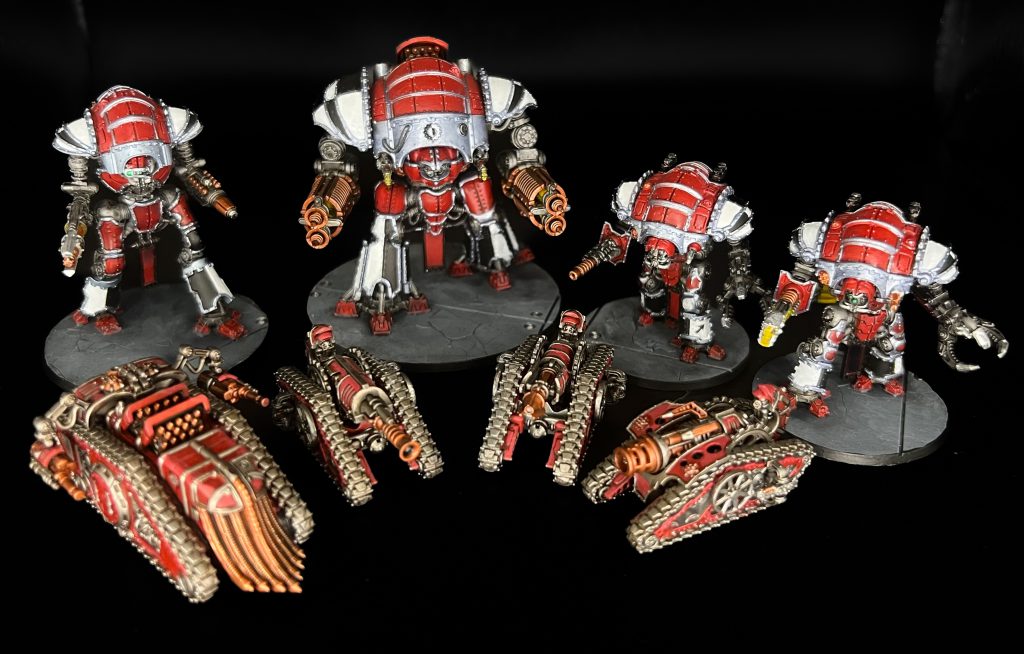
We’d like to thank Games Workshop for sending a box each of these to play with. Five boxes of models was more than I could finish in time for this review so I’ve made one of each variant to try and give you a picture of what you’d be getting.
Mechanicum Krios Squadron
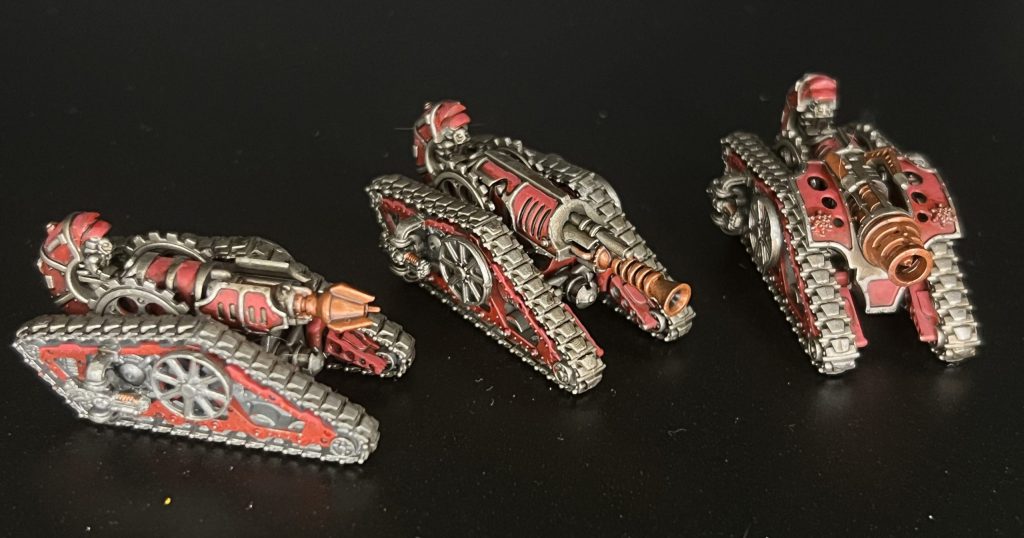
This is a box of six little vehicles, which are extremely loosely described as “tanks”. Unusually for a tank they have no armour whatsoever, with all their vital components and their one crewman openly on display.
This means they’re quite fun models, with even more detail than we are used to on GW’s existing epic scale vehicles. The open sides reveal all sorts of wheels, pipes and radiators and each one has four big cog wheels that presumably do something important.
Unlike the “big 30k” version of the Krios, these have Volkite Caliver sponsons. These are the fiddliest bits of the Krios kit but, like the rest of it, they go together perfectly well.
I wanted to see if I could magnetise the Krios to make its weapons swappable. This turned out to be tricky because there are no big contact areas. Instead of using magnets I used a bit of paperclip going right through the gun mount and into the hull on either side. It holds together well without needing magnets and I could do this with the other guns in future.
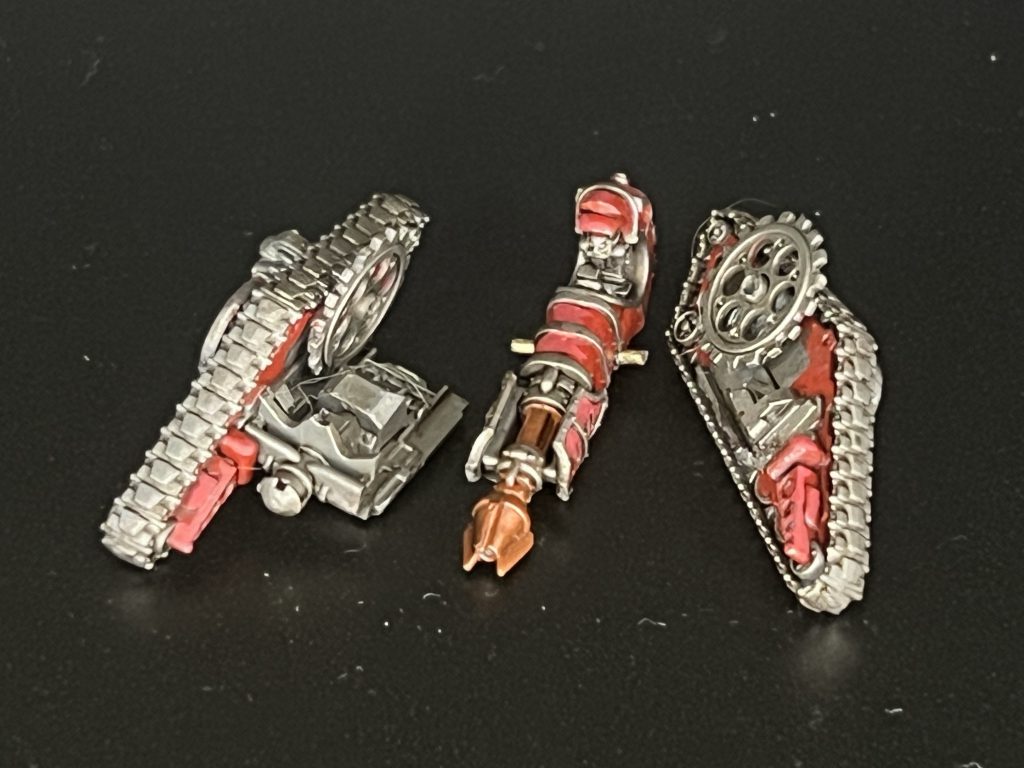
The Venator has a gun shield – naturally full of holes to save weight – and I’ve glued mine on so that tank can’t be anything else now. You could just leave that off if you wanted the option of swapping.
The box contains a slightly odd number of weapons. You get six Lightning Cannons but only four Irad-cleansers and Pulsar-fusils, which the Venators are armed with. Unfortunately this means you’ll be stuck with a spare tank if you make a squadron of three standard Krios and two Venators out of one box, as neither squadron lets you add single extra vehicles. With two boxes you could make two squadrons of three standard Krios and three of two Venators. It’s a shame they don’t let you add single tanks to either type of squadron.
Overall I was impressed by this kit’s level of detail and by how little clean-up it required. Other than sprue gates I really didn’t have to remove any mould lines, even on the tracks, which are often a problem.
I painted my Krios in sub-assemblies, as otherwise it would be very tough to reach the details around the gun. I assembed the various guns, built the sides including their sponsons and stuck the floor onto one side. I sprayed all the bits leadbelcher, added some red and copper paint and then washed the whole thing in Agrax, before doing a bit of highlighting here and there. This wasn’t a long or difficult process really and I think the outcome is pretty good, given how long they took.
Mechanicum Karacnos Squadron
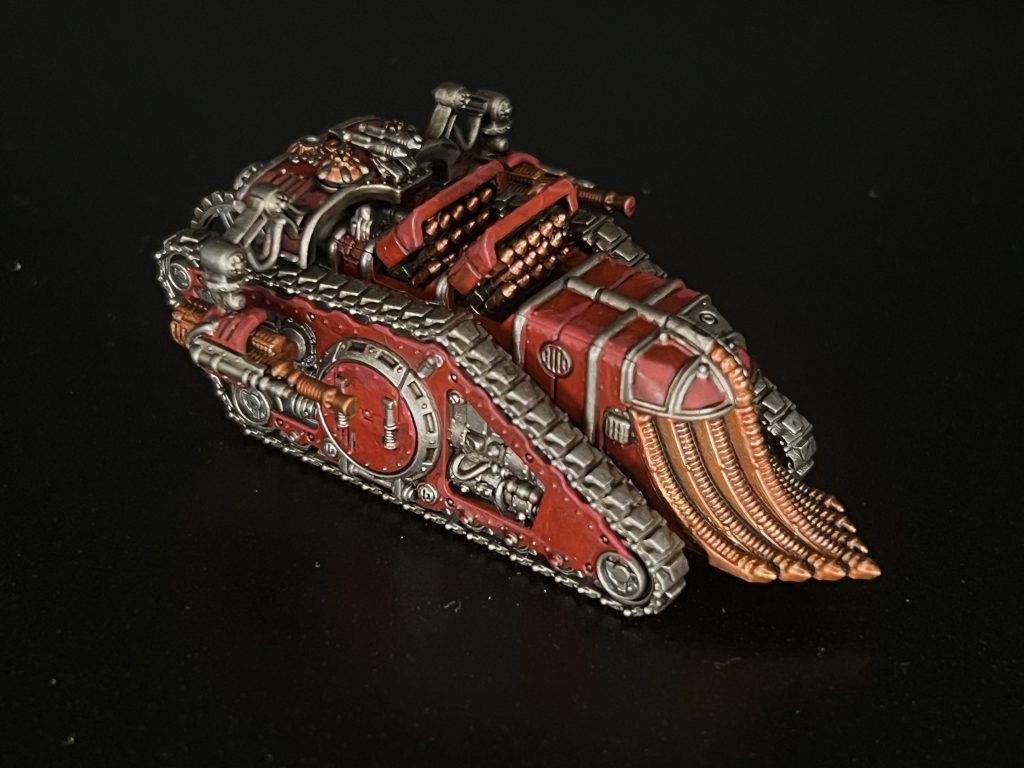
The Karacnos is a lot bigger and chunkier than the Krios, though oddly in the game it’s no more durable. It doesn’t have any weapon options, so unlike the Krios there aren’t any questions around what load-out to give it.
You get four Karacnos to a box with each one taking up slightly more than half a sprue. This means there’s a little add-on sprue with the tank’s floor and a few bits of its weapons. It’s a slightly surprising set up of bits – you might expected the body of the tank to be on one sprue and the guns the other – but that’s not really a problem.
As usual, the Karacnos fits together very nicely. There is a slightly unfortunate join where the roof of the front hull meets the sides, which left slight gaps with mine – though nothing major. There were no major mould lines or casting issues.
The mortar batteries are quite cool as each one is made up of multiple rows of warheads, which can then be modeled open or shut. These models are too small for them to hinge, so you do have to glue them one way or the other. The Karacnos looks pretty boring with them shut though.
The side sponsons are really something. For some reason they’re attached to spindly robot arms and separate from the sides of the hull. Instead they’re attached to the roof, via multiple tiny areas of adhesion. I’ve already knocked one of these off just in the process of building the thing, so you can probably expect to do the same when playing. I find I naturally pick up these vehicles with my finger and thumb in a way that would tend to break one or both of these guns off. Not ideal.
That said, this is a great representation of the larger-scale Karacnos. I can’t really criticise the people who made this kit for its design, as they didn’t design it. Instead they had the job of reducing it down to 25% while keeping as much detail as possible, and I think they’ve succeeded at that. Just be careful with them and carry plastic glue at all times.
I painted my Karacnos the same way I did the Krios, with a leadbelcher spray and lots of red paint. It’s more fiddly, especially around the arms that hold the sponsons on, so the leadbelcher needed quite a bit of tidying up. I left the mortar bits off to paint and dropped them several times during the process, though I’m happy to report I found them again every time.
I think the result is actually pretty great. This is one of my favourite LI vehicles I think, covered in detail that somehow gives it a sense of being a seriously hefty machine. It’s just a bit strange it only has one wound, as it looks like a really substantial piece of kit. They look great in-game too so I imagine I’ll paint a few more of them.
Acastus Knights Asterius

The mighty Asterius takes up a whole sprue by itself, so you get two per box. It’s almost as big as a Warhound but with finer detail – which you won’t necessarily be grateful for when it comes to painting the trim.
It’s a simple enough build, with all the parts fitting together easily and barely a mould line in sight, which is good because cleaning lines of all these rivets and cables would be awful. When building, just be careful you get the correct leg plates on everywhere, as there are some similar-but-different ones on the lower legs. Better to get that right during construction than find the feet stick on at weird angles.
The Asterius is a lot like the much older Porphyrion, except with Mechanicum details. The major difference is the arms, which are quite a bit more flexible. Where the Porphyrion essentially just has a big turret stuck on each shoulder, the Asterius has arms with guns on the end, and a flexible joint at the elbow. As such, of all the Mechanicum Knights, the Asterius is the most visually distinct from its Imperial cousin.
There are no options with the Asterius. Building one uses up every piece on the sprue, which then goes in the bin. I’m terrible for holding onto sprues with bits that might come in handy one day, so this is always satisfying.
A downside of having one knight per sprue is that the Asterius’ legs aren’t poseable. It comes in a very static pose, which you can’t easily modify. I decided to have a go at making mine look like it was walking along but to do that I’d need to change the angle of the feet, which have a ball joint at the ankle but are held in place by pistons.
First I cut off the front and pistons from both legs and one of the back ones. On the right leg I simply swapped the front and back pistons over, while on the left I moved it a bit up the front of the leg. The result was the right leg tilted back on its foot, while the left tilted forward.
The waist was fairly simple to change. I cut off the bit of hose connecting it to the upper leg, stuck it straight back on at a slightly different angle and then glued the legs on. Each leg is also attached to a piston and cable but I found these easy to bend to fit the legs’ slightly changed position. I think I’ve managed to get my Asterius to look like it’s plodding slowly along, as it probably would.
Unlike the Porphyrion, the Asterius has arms that can be posed fairly freely. I’ve tried to give mine a slight swing, while keeping them level and aimed forward. I think this gives it a bit more character than the Porphyrion, which is kind of a walking gun turret.
There’s also has a roof hatch with a load of mortar rounds in, like the Karacnos, which I’ve modeled open. You could leave it shut to get the rounded “murder turtle” look if you wanted but I’d hate to hide detail like this. The hinge at the back is quite a small point of contact for glue unfortunately, meaning the mortar is quite vulnerable to getting knocked off during play or in transit.
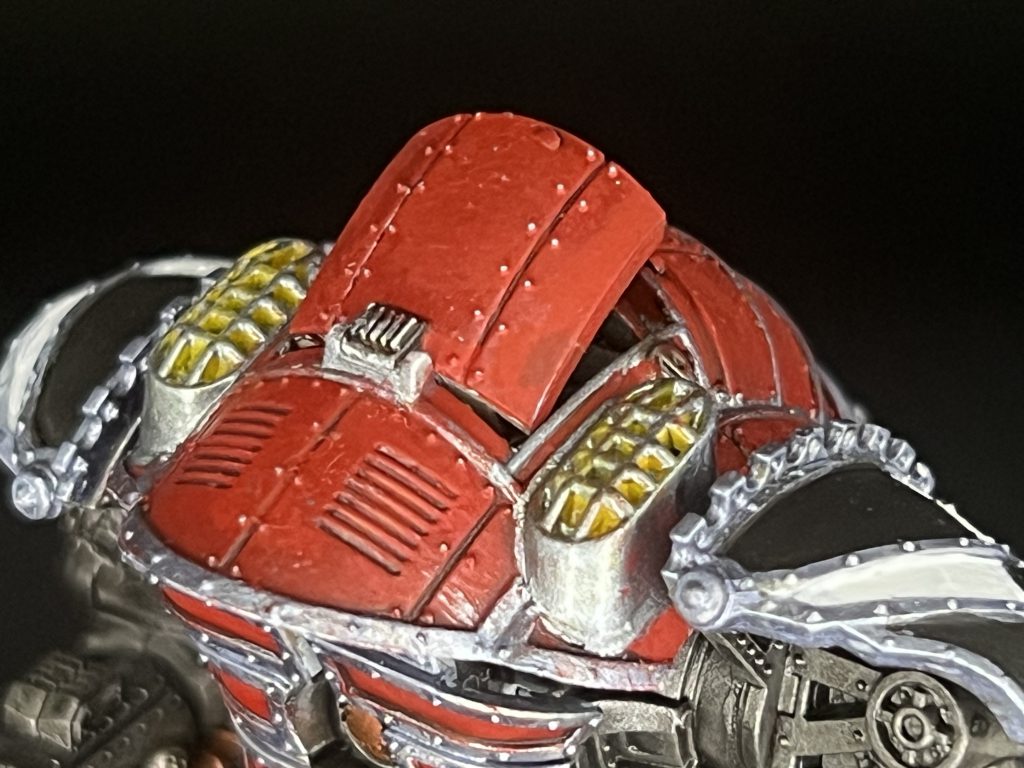
I decided to paint my Knights as house Taranis. I undercoated them with Grey Seer and then brush painted vallejo metal air engine manifold over the skeleton. The red bits start from Mephiston red like my tanks and there are black and white parts. I’ve done a bit of a glow here and there in yellow – in theory these are all sorts of different types of weird weapon and might glow different colours but I wanted a unified look. I used a couple of other metallic colours on things like weapons and pistons.
The trim is done in Grey Knights Steel and wow, there is a lot of it. There’d be a good argument for painting the trim first and filling in the colours on Mechanicum Knights but it didn’t occur to me to do that till too late. The Asterius definitely has more trim by length than most Titans, so be ready for that if you get a box of these.
I haven’t got round to painting any insignia on them or adding transfers. I ran out of time to be honest, but also it’s a bit complicated as different sources have conflicting designs for the scheme, including whether they were actually red or blue as described in the Mechanicu heresy book. I’ve got some transfers from the Ignatum Titanicus sheet but they’re too big to stick on these things, which is no use. I’m planning to go with a scheme in the Imperial Knights Companion, which says that at this time Taranis had a symbol of two arrows. That ought to be achievable with a brush.
Cerastus Knights Atrapos
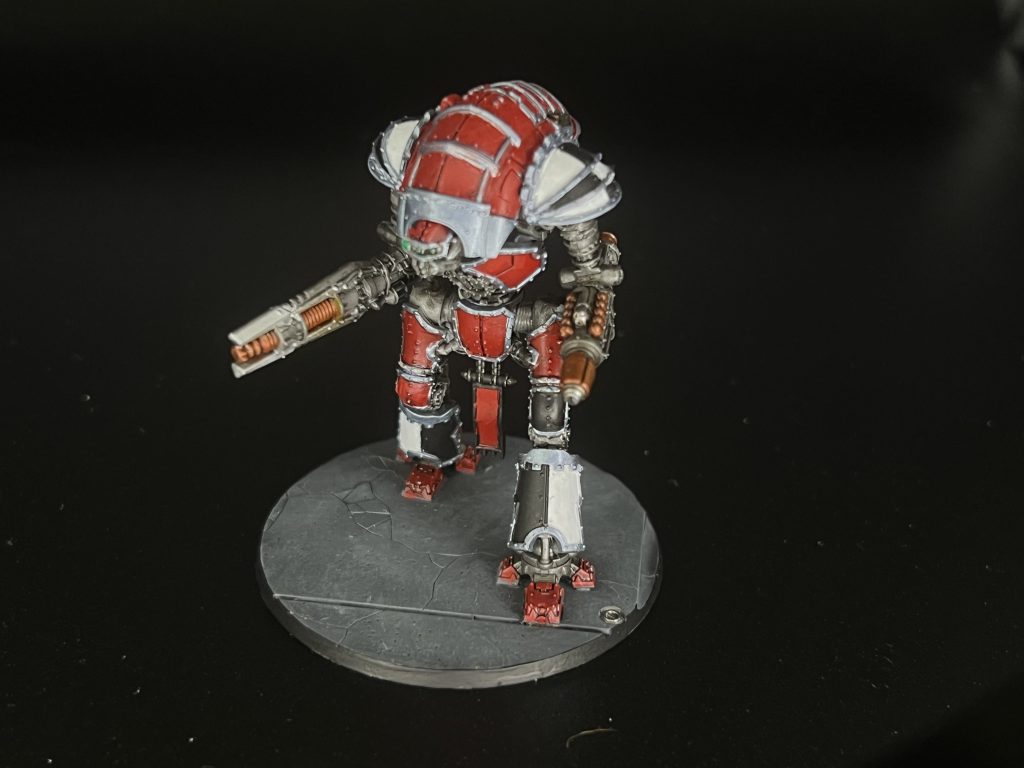
We’ve had two previous Cerastus Knight kits before; one for Lancers and one for Acherons and Castigators. This kit gives you four Atrapos, two to a sprue. They are pretty similar to the Cerastus we’ve seen before, though with Mechanicum detailing.
This kit is highly detailed but actually seems to have slightly fewer parts than some the other Cerastus Knights. This means there’s room on the sprue for some fun options including various different head designs (copied from now-OOP resin ones that Forgeworld used to make) and alternative armour plates with Mechanicum symbols on.
I made one Atrapos straight out of the box, which was a straightforward process. All the parts go together perfectly and you have a bit of freedom with the pose as the waist, neck and arms are all flexible. Unusually, the elbow is slightly articulated on these, letting you angle the guns up and down. You also get some different shoulder joints, angled slightly further out to give more flexibility.
Overall this feels like an upgrade over the resin kit, not just a replication. Rivet-counters will be particularly pleased to see that the armour on the upper leg, seen on the big version but not the little resin one, is back.
I decided to do something a bit different with another Atrapos to represent my Baron or Seneschal. I modelled it crunching over some bits from the ruins kit and used all the Mechanicum armour plates. I magnetised the arms so that it can represent either an Atrapos or a Lancer. The Lancer version uses some spare parts I had, including a Paragon Blade from one of the Age of Darkness Praetors. I haven’t painted him yet but he’s next in the queue.
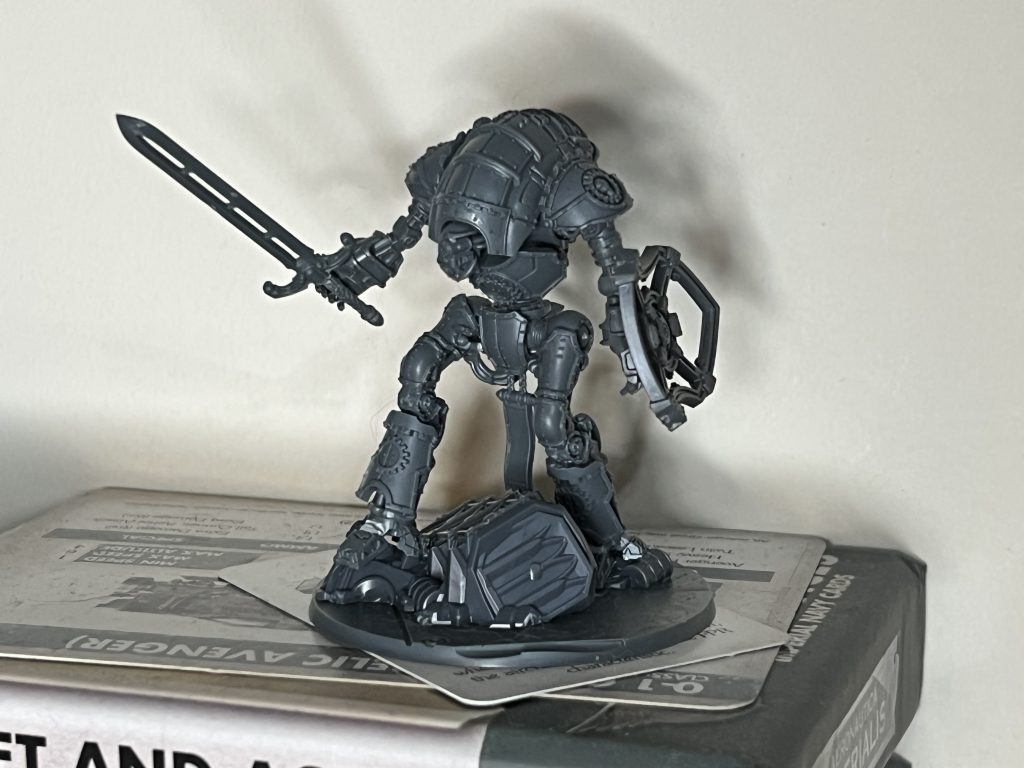
Questoris Knights Magaera and Styrix

This kit makes two Magaera and two Styrix. I’ve seen an article on WHC saying they could be built as either type but that’s not the case. This is two and two. You actually have to be a little bit careful when building them as parts like the back and power plant are different for the two types of knight, so that the power leads to the guns can fit on them.
Like the other Questoris Knights, these guys are much shorter than the Asterius and Atrapos. If anything they are more detailed, however, with cables linking their guns to their power plants and separate fingers that you need to stick onto their claws. There’s some extremely fine detail here, like the Styrix’s tiny grav gun.
This kit feels like a slight upgrade to the older Questoris kit but it isn’t a huge departure. The arms are quite a bit more detailed, with separate fingers on their claws and power cables for their guns. This does mean you can’t do anything with the pose of the gun arm, but their pointed forward naturally enough so that’s ok.
Their little legs didn’t inspire me to try anything adventurous with posing so I just built them straight out of the box. They look perfectly happy waddling along. At this scale a Questoris Knight isn’t very scary – if anything it’s cute – but it still towers over infantry and dreadnoughts… relatively.
Conclusion
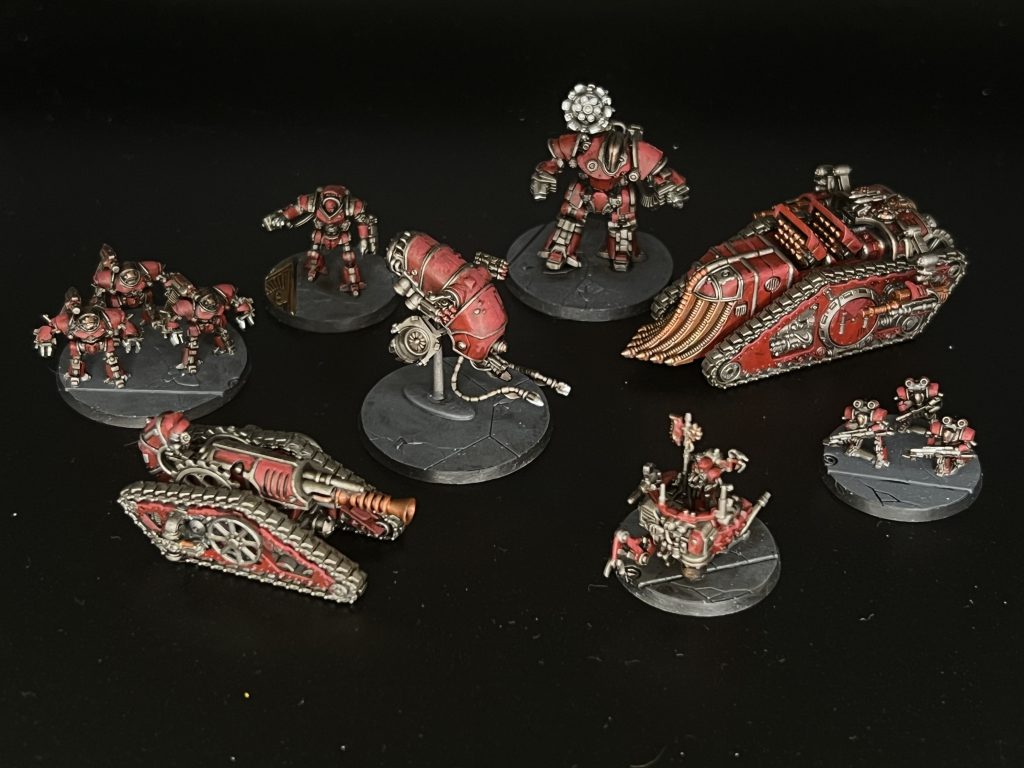
It’s nice to have everything for the Mechanicum released, at least until they design more stuff. The faction now has a full range of really nice models that look very distinct to Legion or Solar Auxilia armies. I’ve found all of them fun to build and paint. They do have some gaps unfortunately – perhaps most notably having no aircraft and nothing capable of anti-air. In the background they sometimes use Avengers and other Imperial aircraft, so the simplest thing would be to use those.
This is an awful lot of new knights. If you buy all three boxes you get 2260 points worth of them in Legions Imperialis, which is enough for a whole army if you took 740 points of allies. It makes Knights by far the cheapest way to fill up points in Legions Imperialis.
To be honest though, Knights cost far too many points at the moment in LI, making them very unattractive. An army made from these boxes would have a really hard time competing with an infantry-heavy force.
The story is rather different in Adeptus Titanicus. The Asterius is probably the most overpowered unit in the game, able to fire a ridiculous four S9 5” blasts. Its firepower is easily equivalent to a battle titan, especially as all that counts as a single weapon system, so you can fire it twice per turn on First Fire.
Both Questoris and the Atrapos are fine in AT and quite interesting. They bring fun effects like a blast gun for the Lightning Cannon, voidbreaker on the Volkite and secondary guns that do automatic hits on enemies within 3″. Their weapons tend to be lower strength than other knights but with traits like rending or Fusion to let them spike higher.
Still, as we’ve seen with the recent FAQ for Legions Imperialis, rules are temporary. These models will probably be around for new editions of their games. In the meantime, the kits themselves are great, just as long as you don’t mind painting a few metres of trim.
Have any questions or feedback? Drop us a note in the comments below or email us at contact@goonhammer.com. Want articles like this linked in your inbox every Monday morning? Sign up for our newsletter. And don’t forget that you can support us on Patreon for backer rewards like early video content, Administratum access, an ad-free experience on our website and more.
